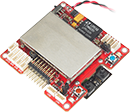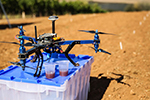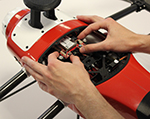![]() Airware provides a complete platform for commercial unmanned aerial systems, commonly known as drones. Regulation of commercial drones into U.S. airspace by 2015 is required through the FAA Modernization and Reform Act of 2012 signed into law this past February. The initial economic benefit of commercial drones has been estimated at more than $13 billion dollars. With every drone requiring integrated flight control systems, Airware is clear for take-off as the possible standard in an exciting new market.
Airware provides a complete platform for commercial unmanned aerial systems, commonly known as drones. Regulation of commercial drones into U.S. airspace by 2015 is required through the FAA Modernization and Reform Act of 2012 signed into law this past February. The initial economic benefit of commercial drones has been estimated at more than $13 billion dollars. With every drone requiring integrated flight control systems, Airware is clear for take-off as the possible standard in an exciting new market.
Autopilot Hardware, Flight Control Software, and Services
Every phase of development and commercialization is offered by Airware. These commercial-grade systems are not for hobbyists. Modular flight control hardware, called an autopilot, is designed for fixed-wing, helicopter, and multi-rotor unmanned aerial systems (UAS). Software on the autopilots for flight control and mission management is all open-source, royalty-free, and Linux-based. Custom hardware solutions and software development services are available for unique customer needs.
Ground control systems are another product offered. Airware’s Ground Station Interface (GSI) and accompanying application software communicates with drones for manual in-flight control and mission configuration. The GSI also includes a Hardware-in-the-Loop Simulator (HIL-Sim) feature for conducting simulations and development testing.
Precision Agriculture and Public Safety
Commercial drones with Airware programmable systems have many real-world uses. Association for Unmanned Vehicle Systems International is a global non-profit organization devoted to advancing the unmanned systems and robotics community. AUVSI recently released an economic report about commercial drones in the U.S. They concluded precision agriculture and public safety are the two largest markets for commercial drones.
Public safety uses for commercial drones go beyond law enforcement. Firefighters, professional medical providers, and even volunteers could use programmable drones for search-and-rescue missions, disaster response, and crime prevention.
Precision agriculture refers to remote sensing and precision applications. Remote sensing involves “a variety of remote sensors being used to scan plants for health problems, record growth rates and hydration, and locate disease outbreaks.” Precision applications utilize “effective and efficient spray techniques to more selectively cover plants and fields. This allows farmers to provide only the needed pesticide or nutrient to each plant, reducing the total amount sprayed, and thus saving money and reducing environmental impacts.” Several blogs already exist about farming with drones, including Robohub and Aerial Farmer.
Airware Is A New Approach To Commercial Unmanned Aerial Systems
Airware’s competitors are generally closed-source autopilots and hobbyist systems. The closed-source autopilots lack flexibility and customization features. The hobbyist systems are not reliable or mature enough for commercial uses. Airware’s Unified Autopilot Interface and open architecture allow drones to be configured for any industrial environment.
Airware’s engineering staff has over 30 years of UAS industry experience. Their capabilities include “skillsets required for UAS development including expertise in: Guidance Navigation and Controls, mission software development, embedded hardware design, payload integration, and flight testing.”
Existing FAA regulations currently prevent Airware from selling their products to U.S. customers for at least another year. Airware autopilot systems are already being used for a variety of uses throughout the rest of the world.


![Apple iOS 7 iBeacon Is A Big Opportunity: A New Platform for Micro-Location Using Bluetooth LE [Video]](../wp-content/uploads/2013/10/ios7-sdk.jpg)



